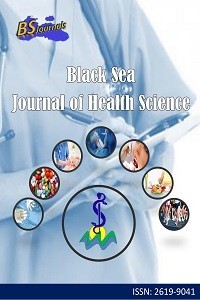Mikrogravitenin Elektroensafalogram Bulguları Üzerine Etkisi: Bir Derleme Çalışması
Astronot, Kozmonot, Uzay Uçuşu, EEG, Mikrogravite
Effect of Microgravity on Electroencephalogram Findings: A Review Study
Astronaut, Cosmonaut, Space Flight, EEG, Microgravity,
___
- Cebolla, A., Petieau, M., Dan, B., Balazs, L., McIntyre, J., Cheron, G. 2016. Cerebellar contribution to visuo-attentional alpha rhythm: insights from weightlessness. Sci Rep 6, 37824.
- Cheron, G., Leroy, A., De Saedeleer, C., Bengoetxea, A., Lipshits, M., Cebolla, A., Servais, L., Dan, B., Berthoz, A., McIntyre, J. 2006. Effect of gravity on human spontaneous 10-Hz electroencephalographic oscillations during the arrest reaction. Brain Res 1121,104–116.
- Clement, G., Reschke M.F. 2008. Space Neuroscience: What is it?. Neuroscience in Space. New York: Springer.
- Mathewson, K.J., Hashemi, A., Sheng, B., Sekuler, A.B., Bennett, P.J., Schmidt, L.A. 2015. Regional electroencephalogram (EEG) alpha power and asymmetry in older adults: a study of short-term test-retest reliability. Front Aging Neurosci, 7 (177), 1-10.
- Murasic, U., Meeusen, R., Pisot, R., Kavcic, V. 2014. The brain in micro- and hypergravity: The effects of changning gravity on the brain electrocortical activity. European Journal of Sport Science, 14 (8), 813-822.
- Nicogossian, A.E., Williams R.S., Huntoon, C.L., Doarn C.R., Polk, J.D., Schneider, V.S. 2016. Space Physiology and Medicine (14. Ch.Behavioral Health and Performance). New York: Springer
- Stella, A.B., Milos, A., Furlanis, G., Manganotti, P. 2021. Neurophysiological adaptations to spaceflight and simulated microgravity. Clinical Neurophysiology, 132,498-504.
- Van Ombergen, A., Demertzi, A., Tomilovskaya ,E,, Jeurissen, B., Sijbers, J., Kozlovskaya, IB., Parizel, PM., Van de Heyning, PH., Sunaert, S., Laureys, S., Wuyts, FL.2017. The effect of spaceflight and microgravity on the human brain. J Neurol., Oct;264 (Suppl 1), 18-22.
- Yayın Aralığı: Yılda 4 Sayı
- Başlangıç: 2018
- Yayıncı: Cem TIRINK
Evaluation of Preoperative Anemia Prevalence in Elective Minor Surgery in Children
İlkay CEYLAN, Hamide Ayben KORKMAZ, Derya KARASU
Fatmanur SÖKÜCÜ, Sedat YİĞİT, Emine PEKTAŞ, Hatice MUTLU ALBAYRAK, Peren PERK YÜCEL, Serkan USGU, Yavuz YAKUT
Hemşirelik Eğitiminde Bir Simülasyon Oyunu: “Klinik”
Kedi Isırığı Sonrası Yumuşak Doku Enfeksiyonu
Servan VURUCU, Sevil ALKAN, Anıl AKÇA, Taylan ÖNDER, Cihan YÜKSEL, Safiye Bilge GÜÇLÜ KAYTA
Orthodontic-Surgical Treatment of a Skeletal Class II Malocclusion: A Case Report
Aylin KAYADÜĞÜN, Muhammed Hilmi BUYUKCAVUS, Yavuz FINDIK, Timuçin BAYKUL
Bibliometric Analysis of Publications on Pulmonary Rehabilitation
Sevim BALTALI, İlkay CEYLAN, Veysel ERDEN
Azize Reda TUNÇ, Halil İbrahim ÇELİK, Mustafa SARI, Demet ÖZTÜRK, Aynur Ayşe KARADUMAN
